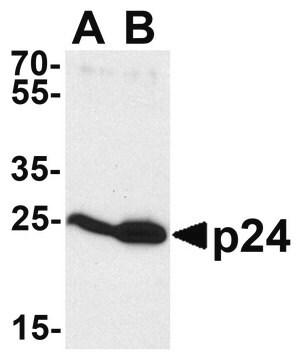MAB880-A
Anti-HIV Antibody, p24, clone 7A8.1
clone 7A8.1, Chemicon®, from mouse
Sign Into View Organizational & Contract Pricing
All Photos(1)
About This Item
UNSPSC Code:
12352203
eCl@ss:
32160702
NACRES:
NA.41
Recommended Products
biological source
mouse
Quality Level
antibody form
purified antibody
antibody product type
primary antibodies
clone
7A8.1, monoclonal
species reactivity
human
manufacturer/tradename
Chemicon®
technique(s)
immunocytochemistry: suitable
western blot: suitable
isotype
IgG1
shipped in
wet ice
Gene Information
human ... TARBP1(6894)
Specificity
Core protein p24. No cross-reactivity observed to other HIV proteins.
Immunogen
Epitope: p24
p24 isolated from human (native) HIV infected cells.
Application
Anti-HIV Antibody, p24, clone 7A8.1 is an antibody against HIV for use in IC & WB.
Research Category
Infectious Diseases
Infectious Diseases
Research Sub Category
Infectious Diseases - Viral
Infectious Diseases - Viral
Western Blot (1:100) or Immunoperoxidase or Immunofluorescence on human tissue (1:100).
Antibodies are not neutralizing. For extensive dilution, protein containing or other stabilizing medium should be used. Final working dilutions must be determined by end user.
Antibodies are not neutralizing. For extensive dilution, protein containing or other stabilizing medium should be used. Final working dilutions must be determined by end user.
Linkage
Replaces: MAB882
Physical form
Format: Purified
Purified. Supplied in 0.05M Tris Cl, pH 8.0.
Storage and Stability
Maintain at 4°C in undiluted aliquots for up to 12 months.
Other Notes
Concentration: Please refer to the Certificate of Analysis for the lot-specific concentration.
Legal Information
CHEMICON is a registered trademark of Merck KGaA, Darmstadt, Germany
Disclaimer
Unless otherwise stated in our catalog or other company documentation accompanying the product(s), our products are intended for research use only and are not to be used for any other purpose, which includes but is not limited to, unauthorized commercial uses, in vitro diagnostic uses, ex vivo or in vivo therapeutic uses or any type of consumption or application to humans or animals.
Not finding the right product?
Try our Product Selector Tool.
Storage Class
12 - Non Combustible Liquids
wgk_germany
WGK 2
flash_point_f
Not applicable
flash_point_c
Not applicable
Certificates of Analysis (COA)
Search for Certificates of Analysis (COA) by entering the products Lot/Batch Number. Lot and Batch Numbers can be found on a product’s label following the words ‘Lot’ or ‘Batch’.
Already Own This Product?
Find documentation for the products that you have recently purchased in the Document Library.
Shilpi Sharma et al.
Journal of virology, 93(11) (2019-03-15)
The cellular protein bone marrow stromal antigen-2 (BST-2)/tetherin acts against a variety of enveloped viruses by restricting their release from the plasma membrane. The HIV-1 accessory protein Vpu counteracts BST-2 by downregulating it from the cell surface and displacing it
Rui Liu et al.
The Journal of infectious diseases, 208(8), 1221-1230 (2013-07-16)
Many chronic human immunodeficiency virus (HIV) patients suffer from gastric complaints, including gastric tuberculosis and coinfection of other pathogens. Recent work has demonstrated that a variety of nonimmune cells can act as viral reservoirs, even at the early stage of
Envelope proteins of spleen necrosis virus form infectious human immunodeficiency virus type 1 pseudotype vector particles, but fail to incorporate upon substitution of the cytoplasmic domain with that of Gibbon ape leukemia virus.
Stitz, J; Wolfrum, N; Buchholz, CJ; Cichutek, K
The Journal of General Virology null
John D Lapek et al.
Molecular & cellular proteomics : MCP, 16(8), 1447-1461 (2017-06-14)
The mechanisms by which human immunodeficiency virus (HIV) circumvents and coopts cellular machinery to replicate and persist in cells are not fully understood. HIV accessory proteins play key roles in the HIV life cycle by altering host pathways that are
Anje Sporbert et al.
PloS one, 8(5), e64023-e64023 (2013-05-24)
This study describes a simple technique that improves a recently developed 3D sub-diffraction imaging method based on three-photon absorption of commercially available quantum dots. The method combines imaging of biological samples via tri-exciton generation in quantum dots with deconvolution and
Our team of scientists has experience in all areas of research including Life Science, Material Science, Chemical Synthesis, Chromatography, Analytical and many others.
Contact Technical Service








